By Santorini Dave • dave@santorinidave.com
My Favorite Hotels in Dublin
• 5-star: Merrion • Fitzwilliam
• 4-star: The Alex
• 3-star: Fleet
• For Couples: Wilder
• For Families: InterContinental
• Best Pool: InterContinental
• Near Airport: Radisson BLU
• Temple Bar: Morgan
• Trinity College: The Mont
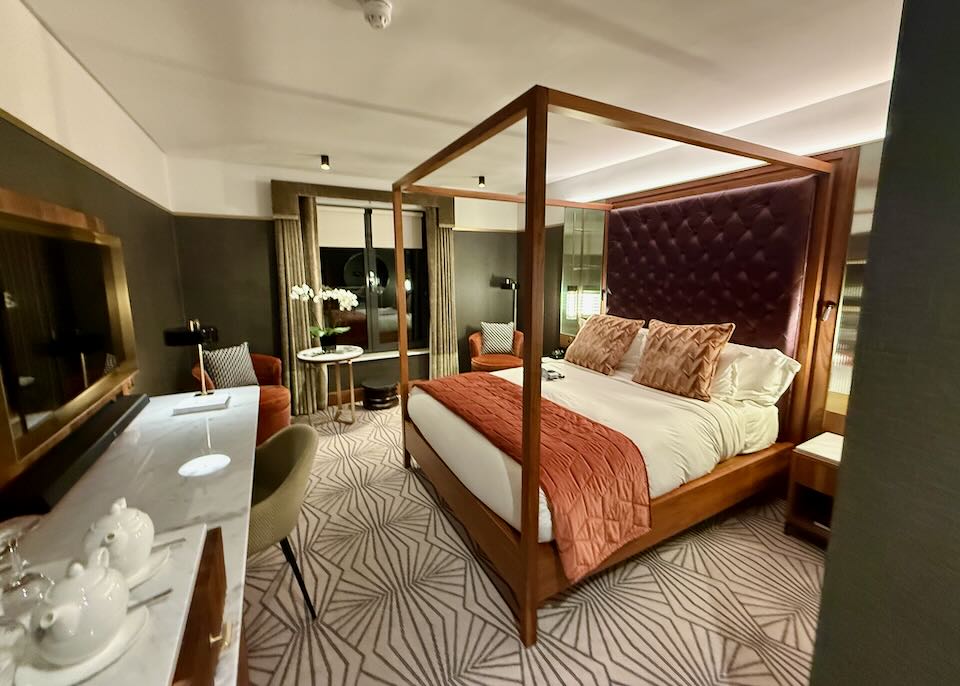
Our room at the Fitzwilliam Hotel in Dublin.
The Best Areas to Stay in Dublin
In rapidly-changing Dublin, it feels like a new hip neighborhood is springing up every other week. Nevertheless, the main sites can still be found just south of the River Liffey, Dublin’s historic center full of graceful Georgian architecture, history, and heritage businesses.
The first stop on any tourist itinerary has to be the country’s most famous squares, Merrion Square & St. Stephen’s Green. Not only are they pretty public spaces in their own right, full of interesting colonial and republican history (don’t miss the statue of former Merrion Square resident Oscar Wilde or the bullet holes from the 1916 uprising in Fusilier’s Arch), but the area also houses several of the country’s most important museums and government institutions, including the seat of parliament. The streets in-between the two are filled with upmarket restaurants, bars, and stores, as well as both of Dublin’s 2-Michelin-Star restaurants. All that, plus the city’s best bus and tram connections.
My wife and I having breakfast at the Westbury Hotel.
Another great area to stay in is Grafton Street & Around. With St. Stephen’s Green at one end and Trinity College at the other – ensuring a constant stream of tourists and locals alike – it’s no surprise that Grafton Street became the most coveted place for national and international luxury brands to set up shop. Don’t miss the streets on the east for exclusive boutiques and artisans. Meanwhile, the four streets parallel to the west of Grafton Street – Clarendon, William, Drury, and South Great George’s streets – have become extensions of both, Grafton Street’s shops and Temple Bar’s nightlife, which means you’ll never need to walk more than five minutes to find the perfect outfit to wear on your pub crawl.
To the west of Trinity College, clinging to the south bank of the River Liffey, Temple Bar had been left to rack and ruin until the 1990s, when it was revived as Dublin’s ‘cultural quarter’. Packed with pubs, restaurants, eccentric stores, and nightlife, the neighborhood is unmissable if you’re looking for a good night out on the town, a unique souvenir, or live music, which you’ll hear drifting out of many of the pubs. All this activity can mean that staying in this area comes with a certain level of noise, but, on the other hand, you might be lucky enough to get river views, seconds from some of the best food and drink in town, and within a 15-minute walk of most of the top attractions, including the revitalized Northside, which you can access via Temple Bar’s picturesque Ha’penny Bridge.
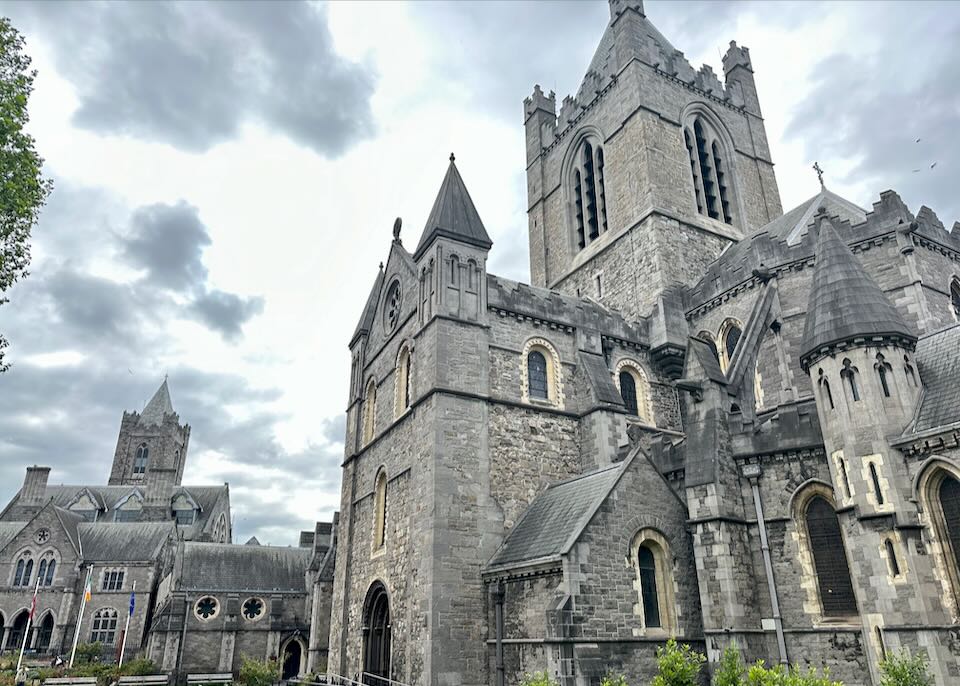
Beautiful Christ Church Cathedral sits midway between Temple Bar and The Liberties.
If waterways and a mix of old and new are your thing, head for the Docklands, an area whose regeneration has attracted tech giants Google and Facebook among others to erect glassy office buildings among old warehouses and dilapidated workers’ cottages. The banks of the Liffey and Grand Canal Dock have become lined with cafes, bars, restaurants, and experiences (water sports and spas) to serve Dubliners benefitting from Ireland’s economic boom years. Another draw of this neighborhood is the big cultural centers and architectural marvels that have sprouted up in the last few years, including the Daniel Libeskind-designed Bord Gáis Energy Theatre, Convention Centre, 3 Arena, and harp-shaped Samuel Beckett Bridge by Santiago Calatrava. Don’t miss the CHQ building in the Northside Docklands, which houses the awesome EPIC emigration museum.
Immersive, interactive, informative, and fun, EPIC The Irish Emigration Museum is a fascinating stop for any visitors boasting Irish heritage.
If you like the thought of getting off the beaten track and staying in a neighborhood with fewer tourists, try the Southside, The Liberties, Kilmainham, or the Northside. Some of the Southside neighborhoods, Portobello, in particular, are within walking distance of the center and are fast overtaking Temple Bar for locals looking for a good night out, with Camden Street Lower being a hive of trendy bars and restaurants. Ranelagh and Rathmines are pleasant for their village-like feel (despite being less than a 10-minute tram ride from St. Stephen’s Green), while Ballsbridge, home to the huge Aviva Stadium, is leafy and genteel, with divine canalside Georgian townhouses.
The only reason most tourists used to go west of the center was to see the famous Guinness Storehouse. Today, the neighborhood it’s in, The Liberties, is worth a visit in its own right. A few craft distilleries and breweries that offer their own experiences have popped up in the area, and the gentrification around Thomas Street and Meath Street has resulted in cool stores, cafes, and restaurants. The neighborhood to the west is Kilmainham, housing the Kilmainham Gaol and the Irish Museum of Modern Art (IMMA), which makes a great day trip, especially if combined with a walk in the War Memorial Gardens.
On the traditionally poorer Northside of the Liffey, many cool young chefs and mixologists have set up shop on the streets between the river and Henry Street, bringing a buzz to the area. The winds of change are even coming to the much-neglected boulevard O’Connell Street, with its odd metal spire and grotty casinos, and a couple of exciting new mixed-use developments sprouting up nearby. The north has a wealth of sights, too, but they’re just more spread out than the more compact south: there’s the vast Phoenix Park; the Museum of Ireland at Collins Barracks; great shopping between Henry Street, Capel Street, and the old-fashioned Moore Street Market; Parnell Square with the wonderful Hugh Lane Gallery and moving Garden of Remembrance; and an artsy regeneration in Smithfield, whose characterful old distillery buildings have come alive with restaurants.
The Best Places to Stay in Dublin
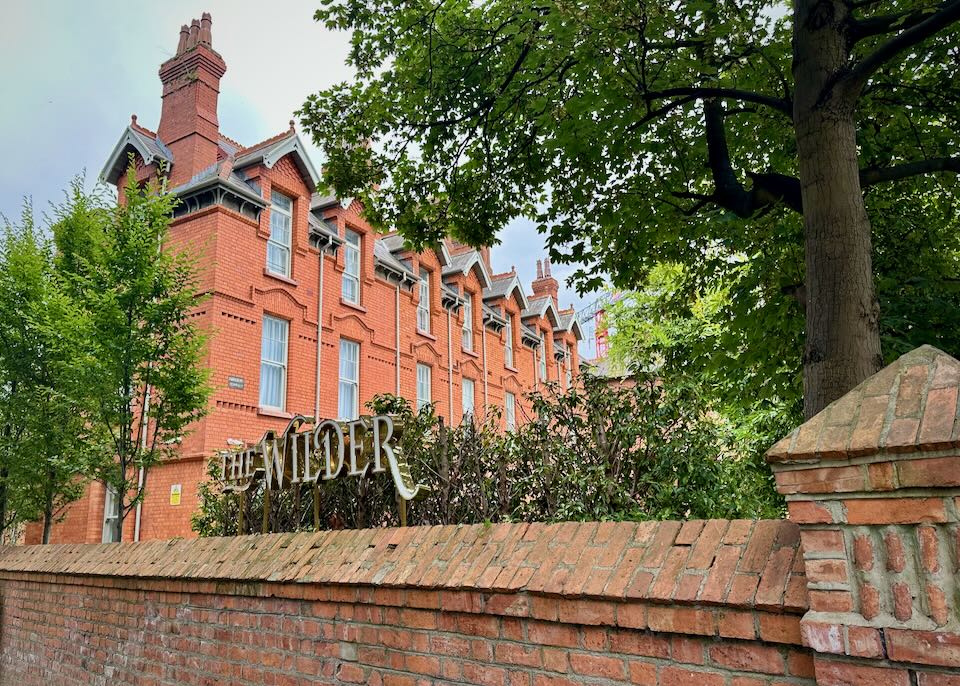
The Wilder hotel in Dublin is a great boutique spot we recommend for couples.
- Best Luxury Hotels in Dublin
Merrion • Shelbourne • Fitzwilliam • Westbury- Best Boutique Hotels in Dublin
Wilder • Mont • Clarence- Best Cheap/Midrange Hotels in Dublin
Fleet • Schoolhouse • Iveagh Garden • McGettigan’s Townhouse • Generator- Best Hotels for Families in Dublin
InterContinental • Parkway GuesthouseMy wife and son outside the Parkway Guesthouse on our first trip to Dublin many years ago.
Best Areas in Dublin for…
- Best Areas in Dublin for Sightseeing: Merrion Square & St. Stephen’s Green
If you’re in Dublin only for a day or two, focus your time around these graceful squares which are packed with some of Dublin’s best sights, including the National Gallery, two of the four museums that make up the National Museum of Ireland, and the seat of government, Leinster House. Not only have the Georgian-era squares and the streets surrounding them played a central part in Irish history, but they both also have pleasant parks as their centerpiece, which are always bustling with a mix of locals and tourists. As you walk around the squares, you’ll notice plaques to their most famous denizens, including WB Yeats and Oscar Wilde; don’t miss his highly unusual statue in the northwestern corner of Merrion Square. In St. Stephen’s Green, there are several of statues and monuments dedicated to the people and historical moments that have shaped the city; many city tours start from here as it really is the city’s main square.- Best Area in Dublin for Nightlife: Temple Bar
Temple Bar is a tiny neighborhood that is packed to the rafters with great restaurants, pubs, and live music venues. Its success as the center of Dublin’s nightlife has spread to the streets south of Dame Street which come alive with groups of Dubliners and tourists looking for good craic (news or gossip). A great Dublin night would begin with a pint at one of the city’s best and beautiful pubs – try The Long Hall, The Stag’s Head, or The Palace Bar – before hitting a trendy restaurant followed by live music – try the Button Factory, the Porterhouse, or Gogarty’s. If you can stomach it, have a pint or two more at Grogans before ending the night with one of their famous toasties. The major drawback to a night out in Temple Bar is the price: you’ll pay top brass to drink on these cobbled streets. For a less touristy (and cheaper) night out, head to Camden Street Lower; it’s less than a 15-minute walk directly south of Temple Bar.
- Best Areas in Dublin for Food and Restaurants: Merrion Square & St. Stephen’s Green
Dublin has recently enjoyed a gastronomic boom and you can now find wonderful restaurants all over the city. However, thanks to the ongoing importance of Merrion Square & St. Stephen’s Green in civic life (the area is filled with government officials) and tourism, those neighborhoods have a high concentration of great restaurants, including 2-Michelin-Stared Patrick Guilbaud. This sits just off Merrion Row, which boasts tons of superb eateries, including Cirillo’s, Etto, Hugo’s, Brookwood, Bang, Matt the Thresher, and more. Meanwhile, the roads between Dawson Street and Merrion Square have feature great names: Lotus Eaters, Dolce Sicily, Fire Steakhouse, Dunne & Crescenzi, and many more.- Best Areas in Dublin for Families: Merrion Square or the Northside
Merrion Square comes top again thanks to its family-friendly museums and proximity to the river. On the square itself (or just off it) are the National Gallery and two of the four museums that make up the National Museum of Ireland (all of them offer free entry); kids will love the glistening treasures on display at the archaeology museum, while the natural history building is packed with taxidermied animals; the museum hasn’t changed since its inception in 1857. On top of this, there’s an awesome playground in the center of the square, plus it’s only a few blocks from here to the Docklands, where they will delight at the replica 19th-century ship, the Jeanie Johnston, and adore the interactive EPIC the Irish Emigration Museum. Also on the Northside is Phoenix Park, which, with vast open spaces, a zoo, and a fort, is perfect for children.
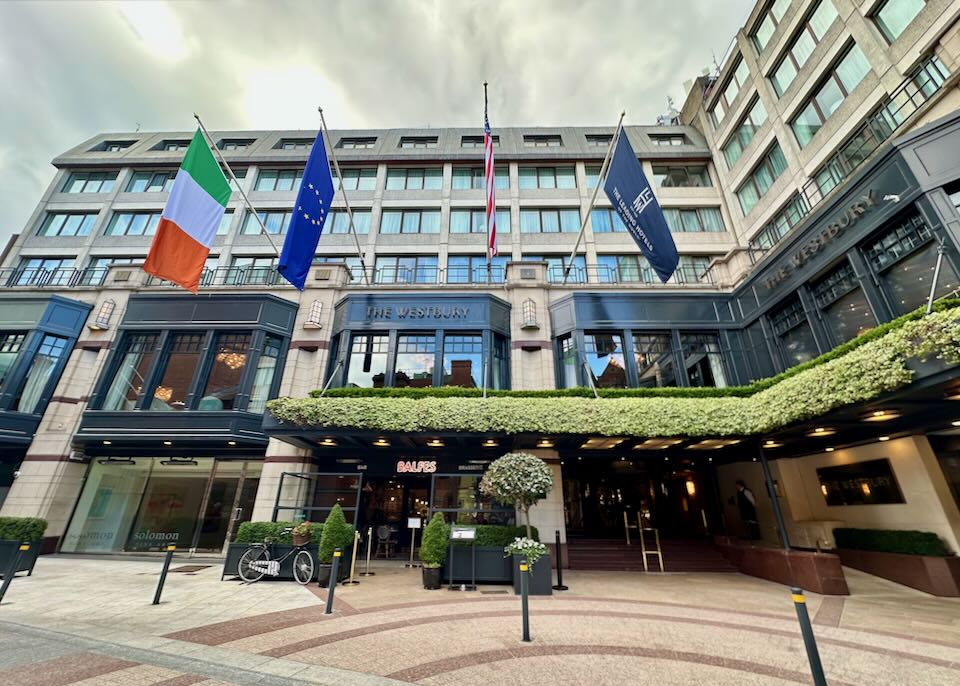
The 5-star Westbury Hotel is located one block off Grafton Street in central Dublin, near Trinity College and St Stephen’s Green.
- Best Areas in Dublin to Stay for First Timers: Merrion Square & St. Stephen’s Green
Central Dublin is very walkable and the great thing about staying somewhere between Merrion Square and St. Stephen’s Green is that you’ll be able to walk to almost every sight worth visiting: parliament and government buildings, the National Gallery, the archaeology and natural history museums, the hop-on-hop-off tour buses which leave from St. Stephen’s Green, Trinity College, EPIC The Irish Emigration Museum, Temple Bar’s pubs and quirky stores, the Ha’penny Bridge, Dublin Castle, and the Chester Beatty Library. Both squares have great transport links (making them the best areas to stay if visiting without a car) and, unlike the area between Temple Bar and Grafton Street, are quiet at night.- Best Area in Dublin for Walking: Along the Waterways
Dublin is an eminently walkable city, with most places on the tourist trails quicker to access on foot than by public transport (walking even beats taxis when traffic’s bad). It’s also very easy to find your way around thanks to its waterways, namely the River Liffey and the Grand Canal. If you walk the Liffey in either direction, you’ll see grand old buildings, derelict warehouses, modern glass structures, and industrial factories. From the center of the city, walking east for an hour will get you to the sea via the Jeanie Johnston, the Samuel Beckett Bridge, and Grand Canal Dock. Alternatively, walk west and you’ll take in the Guinness Brewery, Four Courts, the National War Memorial Park, and Phoenix Park. An alternative would be to follow the canal south from the river through the well-heeled neighborhood of Ballsbridge to the more edgy Portobello to see how the demographic changes.The River Liffey as seen from the Grattan Bridge in Dublin.
- Most Romantic Area in Dublin: Ha’penny Bridge
The charming Ha’penny Bridge is, without doubt, one of Dublin’s most beautiful spots. Constructed in 1816, the pedestrian crossing connects Temple Bar in the south with the Northside. Its popularity has helped both neighborhoods to throb with dreamers, couples, families, and tourists alike who use it to move between the hip stores and restaurants on the north bank and the traditional pubs and cobbled streets in the south. The bridge’s gentle arch helps provide great views of the Liffey river, especially at sunset. Lovers in recent years have demonstrably declared their love each other by fixing padlocks – so-called love locks – to the bridge’s railings (although the city regularly removes them for fear of structural damage). Even the bridge’s name is romantic: its official name, the Liffey Bridge, is significantly less whimsical than its nickname, which refers to the half-penny fee people used to pay to cross in order to compensate the ferryman whom the bridge made redundant.- Best Area in Dublin for a Local Vibe: Southside
Head to one of the neighborhoods south of the Grand Canal to get a sense of ‘normal’ life in the city. A good pick, thronging with eateries, is Ranelagh. You can walk there in under 20 minutes from St. Stephen’s Green (or jump on the Green Luas tram to get there in under 10). The neighborhood’s main street has dozens of great places for any time of day: pick from fine dining (Thai, American, Iranian, Pakistani, Spanish, Italian, etc.), local pubs, specialist coffee bars, delis, and a good bookshop. After eating, wander west through backstreets full of quaint Georgian cottages to neighboring Rathmines, which is slightly less village-like, and features more shops, a craft brewery, coffee roastery, and multiplex, among others.- Safety in Dublin
Dublin is generally very safe for tourists. The biggest risk, as in most European cities, comes from pickpockets or muggers, but the likelihood is low as long as you aren’t flashy with your possessions and keep an eye on what’s going on around you.
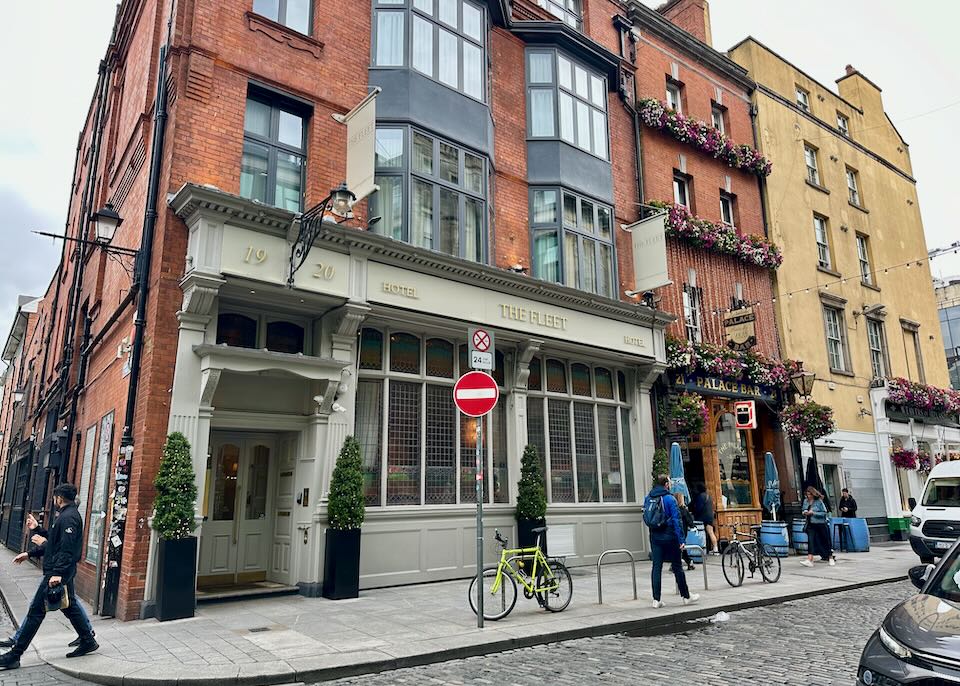
The Fleet is a great midrange hotel in Temple Bar.
The 7 Best Neighborhoods in Dublin for Tourists
1. Trinity College, Grafton Street & St. Stephen’s Green
Trinity College
When people talk about the center of Dublin, they are referring to the area around these three major sights, which lead on from one another as you head south from the Liffey. Ireland’s premier university, Trinity College, takes up a sizeable chunk of central Dublin. It’s primarily of interest for tourists as the location for the show-stopping Long Room library and its greatest treasure, the Book of Kells, an exquisitely decorated version of the New Testament from around 800AD. Access both of these through the college’s cool new Book of Kells Experience. Head south down pedestrian-only Grafton Street for fantastic shopping, both on the main drag and the little streets surrounding it – from international luxury brands to tiny independent boutiques.
The Trinity College Long Room
At the southern end of Grafton Street is St. Stephen’s Green, a Georgian square with a 22-acre park as its centerpiece, full of pretty plants, ornamental Victorian features, and many statues and monuments that will give background and insight into Ireland’s rich history. Look out for bullet holes on the Fusiliers’ Arch at the northwest entrance to the park that date back to the 1916 uprising, when rebels took the square in an attempt to wrestle control from the British government. You can catch city tour buses from the square’s northern side, which is also the location of the very cool and quirky Little Museum of Dublin, containing thousands of artifacts related to the people and events that have shaped the city.
- Best Hotels near Trinity, Grafton Street, and St Stephen’s Green
• The Shelbourne
• The Fitzwilliam Hotel
• The Westbury Hotel
• The Wilder
• Brooks Hotel- Best Cheap/Midrange Hotels
• Iveagh Garden Hotel
• Clarendon Suites2. Merrion Square
This graceful square, laid out in the 1760s, is one of the best places to see the Georgian townhouses that Dublin is so famous for, many of which have been home to some of the city’s most famous denizens, including Oscar Wilde (check out his unusual statue in the northwestern corner of the square) and WB Yeats. Throughout the year, various events are held in the square, and street food stalls pop up for lunch every Thursday.
The Oscar Wilde statue at Merrion Square
There is a concentration of the city’s biggest sights on and around the square: the National Gallery, which features the most comprehensive collection of Irish art in the world; two of the four museums that make up the National Museum of Ireland – the archaeology museum is especially wonderful as it exhibits some of the best surviving Celtic and medieval artifacts in the world; the seat of the Oireachtas (parliament), Leinster House; and the prime minister’s office in the palatial Government Buildings. And this is all less than a 10-minute walk to the Liffey, St. Stephen’s Green, Grafton Street, or Trinity College.
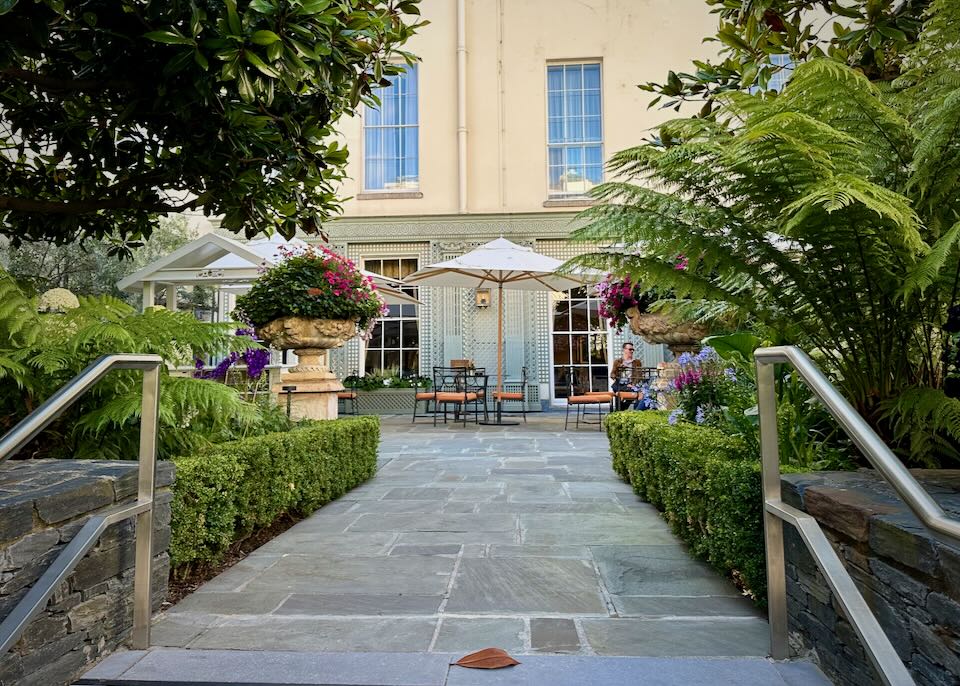
The beautiful garden courtyard of the 5-star Merrion Hotel
- Best Hotels near Merrion Square
• The Alex
• The Mont
• The Merrion Hotel- Best Cheap/Midrange Hotels
• Schoolhouse Hotel
• The Davenport
• Grand Canal Hotel3. Temple Bar
To the west of Trinity College, the Temple Bar district clings to the south bank of the River Liffey; in ruins until the 1990s, when it was revived as Dublin’s ‘cultural quarter’. Packed with pubs, restaurants, eccentric stores, and nightlife, the neighborhood is unmissable if you’re looking for a good night out on the town, a unique souvenir, or live music, which you’ll hear drifting out of many of the doorways. The area can be noisy, but it also offers river views, some of the best food and drink in town, and is within 15-minutes’ walk of most of the top attractions, including the picturesque Ha’penny Bridge that connects to the Northside.
Ha’penny Bridge
A fun addition to the neighborhood is the Irish Rock ‘N’ Roll Museum Experience, which features anecdotes and memorabilia from the many Irish musicians who have shaped popular music, including Thin Lizzy, Van Morrison, U2, Sinead O’Connor, and Enya. There’s also the chance to dress up, rock out and record your own track, see working recording studios that have been used by the likes of Rihanna, Kanye, and Will.I.AM, and go backstage/onstage at the Button Factory, one of Dublin’s coolest gig venues.
- Best Hotels in Temple Bar
• The Clarence
• The Morgan Hotel
• Harding Hotel- Best Cheap/Midrange Hotels
• The Fleet
• The Norseman
• Abigail’s Hostel4. Dublin Castle, Chester Beatty & Dublin’s Cathedrals
Dublin Castle
A patchwork of different styles and eras, Dublin Castle has Viking foundations and was the seat of British rule in Ireland from 1204-1922. It’s worth going on the tour to see the Royal Chapel and State Apartments, which everyone from Benjamin Franklin to Pope Francis has visited over the years. On the same site as the castle stands the amazing Chester Beatty Library. Its eponymous founder, an American mining engineer who made Ireland his home, collected rare manuscripts his whole life and left them to his adopted city. Almost everything on display is stunning: there are some of the earliest surviving Christian artifacts as well as texts, wood cuttings and scrolls from most of the world’s major religions and civilizations.
St Patrick’s Cathedral
Two of Dublin’s most prominent cathedrals sit nearby, Christ Church and Saint Patrick’s. The latter is the national cathedral of the Church of Ireland and is worth a visit for its decorative tiled floors and interesting links to history. Most notably, Gulliver’s Travels’ author Jonathan Swift (1667-1745) was once the dean here and visitors can see his grave and self-penned epitaph. The cathedral was also the site of the first-ever performance of Handel’s Messiah. If you have time, stop into the perfectly preserved Marsh’s Library next door, dating back to 1707.
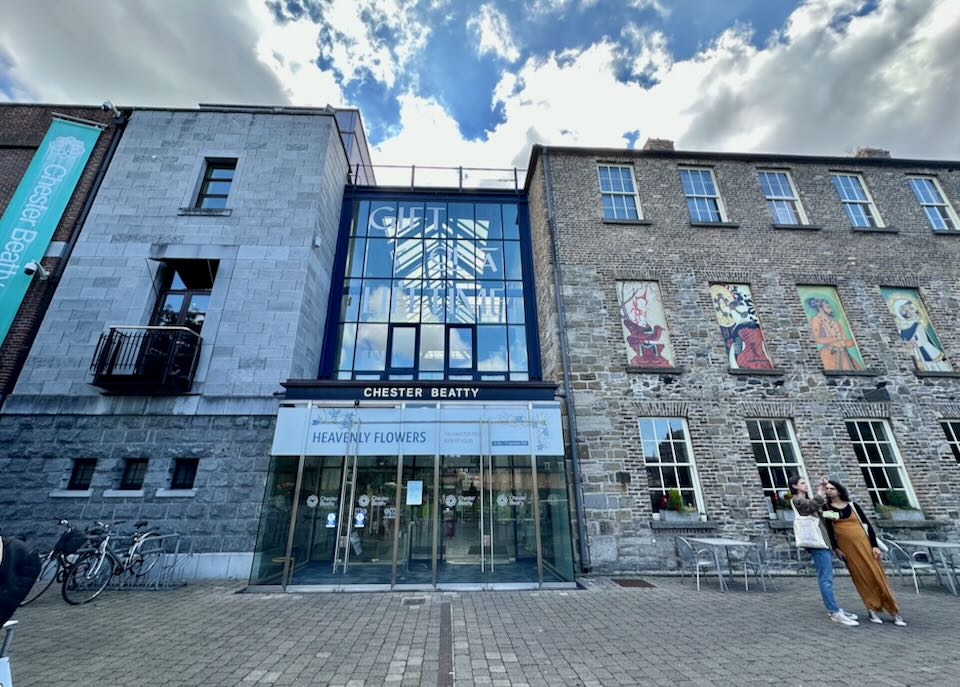
The Chester Beatty Library houses an exceptional collection of rare manuscripts, prints, and artifacts from many different cultures and religions.
- Best Hotels near Dublin Castle, Chester Beatty, and Dublin’s Cathedrals
• Hyatt Centric The Liberties- Best Cheap/Midrange Hotels
Aloft Dublin City5. Docklands
Once aimed almost exclusively at business travelers, this area is rapidly changing as tourists realize how cool it is to stay here. This is largely thanks to the cluster of great attractions right around the Liffey and Grand Canal Dock. There’s EPIC The Irish Emigration Museum, a lively and interactive museum about the Irish diaspora and how the Emerald Isle has influenced the world. There museum even features an Irish Family History Centre, to discover whether there’s Irish ancestry you can claim. It’s housed in the magnificent CHQ Building, a vast and historic riverside warehouse dating back to 1820, nowadays filled with stores and eateries.
Almost on the doorstep of the CHQ are a few other interesting sights, including the authentic replica of the Jeanie Johnston, a ship that made 16 transatlantic voyages with people fleeing the Great Famine of the 1840s, as well as the haunting Famine Memorial, the harp-shaped Samuel Beckett Bridge, and the grand Customs House building. All this and you’re within minutes of Connolly Station, Merrion Square, and O’Connell Street.
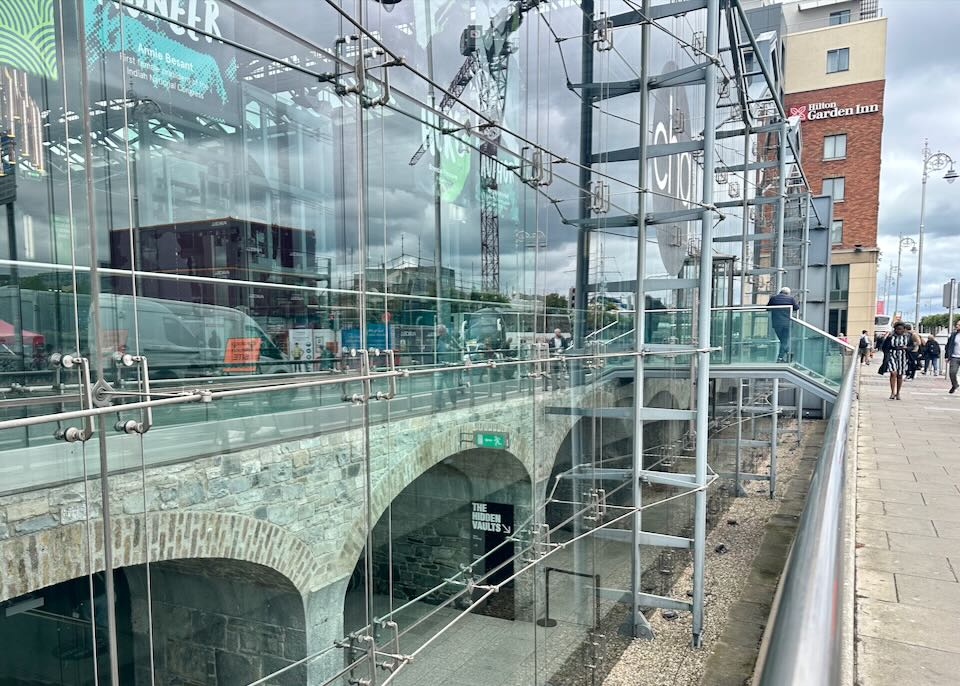
The Hilton Garden Inn Dublin City Centre enjoys a prime waterfront location on the Liffey, right between the EPIC Irish Emigration Museum/CHQ Building and the Jeanie Johnston tall ship.
- Best Hotels in Docklands
• Hilton Garden Inn Dublin City Centre
• The Spencer Hotel
• Ferryman Townhouse6. The Northside
If you’re keen to explore the Northside, it’s obligatory to walk up the formidable O’Connell Street to Parnell Square, the north’s equivalent to St. Stephen’s Green. Along the wide boulevard, you’ll pass the grand old General Post Office that still bears the scars of the Civil War a century on, the dynamic statues of political firebrand Jim Larkin and author James Joyce, the sleek Dublin Spire, and the start of Henry Street for great shopping opportunities. A must-visit is the moving Garden of Remembrance, a lovely spot to relax before visiting the pioneering Hugh Lane Gallery featuring permanent works by Harry Clarke, Sean Scully, and the unmissable London studio of Francis Bacon, which was rebuilt in its entirety after the artist’s death as a gift to the city he was born in. Also, check the listings for the theaters and cinemas in and around the square. Explore Henry Street, Moore Street Market, and Capel Street for lots of great shopping, from a traditional produce market to the enormous Arnotts Department Store and tiny thrift stores.
West of here, the once-industrial Smithfield neighborhood is packed with cool restaurants, hip hotels, and cute stores – plus Dublin’s best pub for traditional Irish music, The Cobblestone. It makes a great base to not only explore the north but also the Southside neighborhoods of The Liberties and Kilmainham.
No matter where you’re staying, it’s worth the trip up to Smithfield for an evening of live music and pints at the Cobblestone Pub.
Just west of Smithfield is the National Museum of Ireland – Decorative Arts & History, housed in the magnificent Collins Barracks. Wonderfully varied, it features displays from war and immigration to fashion and interiors. Finally, any mention of the Northside without mentioning vast Phoenix Park would be an injustice. One of the largest inner-city parks in the world, it is the place to head to if you have a spare day and need to stretch your legs in – what feels like – glorious countryside (there are even wild deer). There’s a lot to see and do, including a Magazine Fort, prehistoric burial chamber, castle, Victorian ornamental and walled gardens, the president’s residence, and Dublin Zoo (and that’s just for starters).
- Best Hotels in the Northside
• The Morrison
• Hotel 7
• Moxy Dublin City
• Maldron Parnell Square
• The Hendrick Smithfield
• Maldron Hotel Smithfield- Best Cheap/Midrange Hotels
• Holiday Inn Express City Centre
• McGettigan’s Townhouse
• Parkway Guesthouse
• Generator Dublin7. Guinness & Kilmainham Gaol
South of the Liffey and west of Dublin’s traditional center are two attractions that are must-sees on most visitors’ itineraries – the Guinness Storehouse and Kilmainham Gaol – in The Liberties and Kilmainham neighborhoods respectively. The Guinness Storehouse is the showcase for the world-famous St James’ Gate Brewery, which has brewed the internationally adored stout since the 1750s. Something of a behemoth, it boasts seven floors dedicated to the beer. You’ll learn about the brewing process and the famous advertising campaigns, and, of course, taste it too. The highlight is the top-floor Gravity Bar which offers 360-degree views of Dublin and beyond (best enjoyed on a clear day).
Kilmainham Gaol
A 20-minute walk away is Kilmainham Gaol, a terrifying old prison that was in use up until the mid-1920s. Independence leader Charles Stewart Parnell and other rebels of both the 1916 uprising and the Irish Civil War were kept or executed in this hellish place that hadn’t changed much since it opened in 1796. In-between stands the Irish Museum of Modern Art, Dublin’s premier contemporary art museum housed in grand old hospital buildings amongst lovely grounds. The permanent collections feature works by world-famous contemporary artists. The National War Memorial Gardens, one of the city’s most delightful parks, are also here. They were designed by the famous architect, Sir Edwin Lutyens, and dedicated to the almost 50,000 Irish soldiers who died fighting for Britain during World War I.
- Best Hotels near the Guinness Storehouse & Kilmainham Gaol
• Ashling Hotel
• Hilton Kilmainham
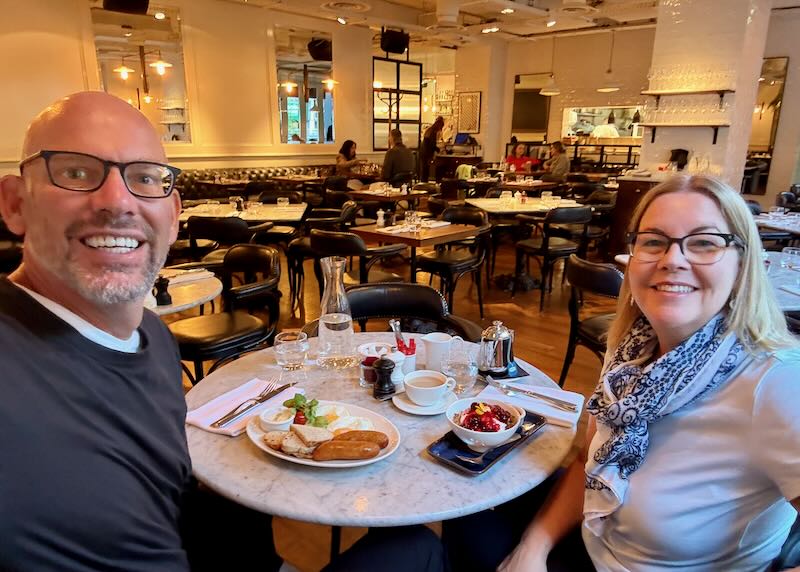
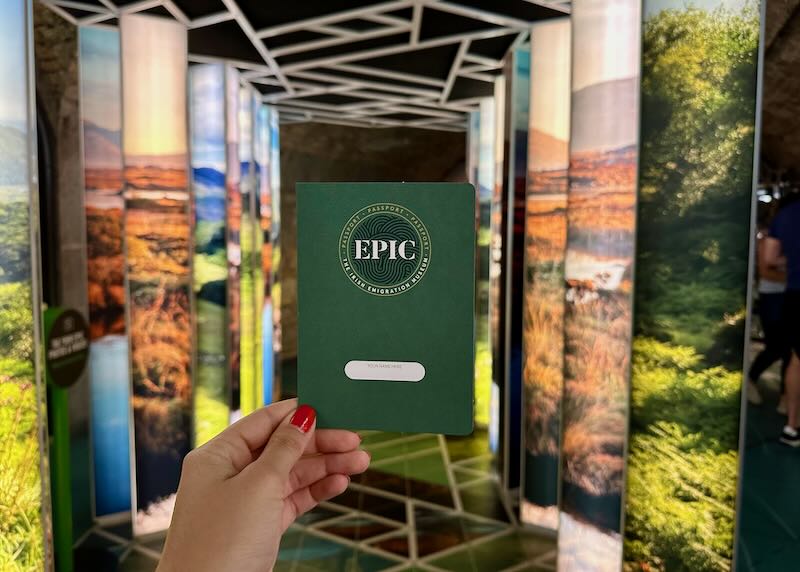
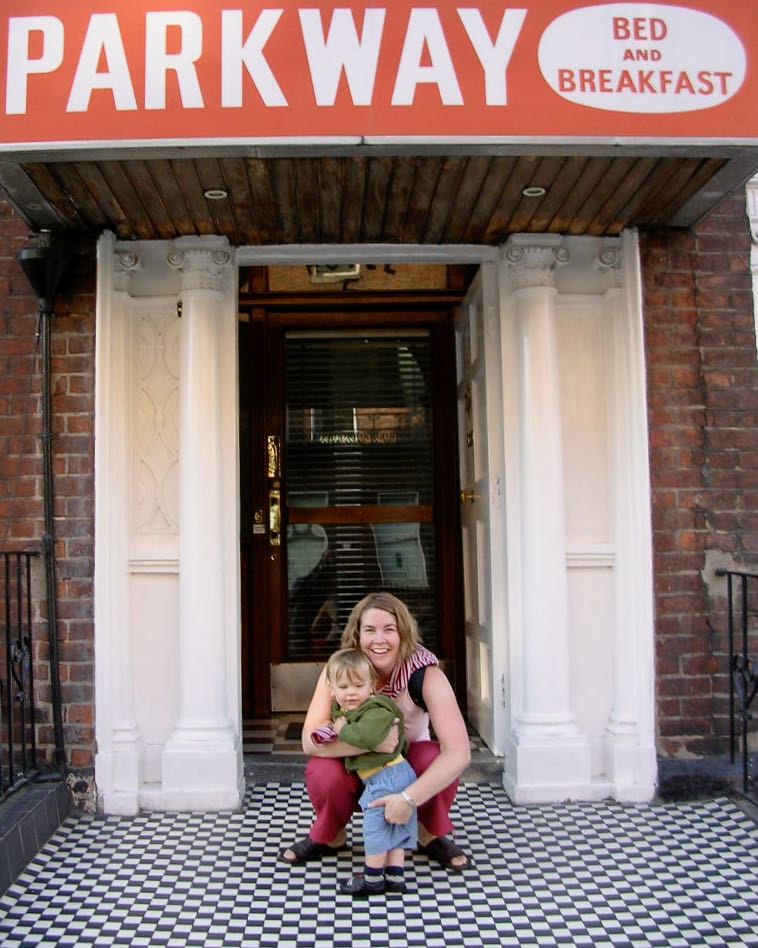
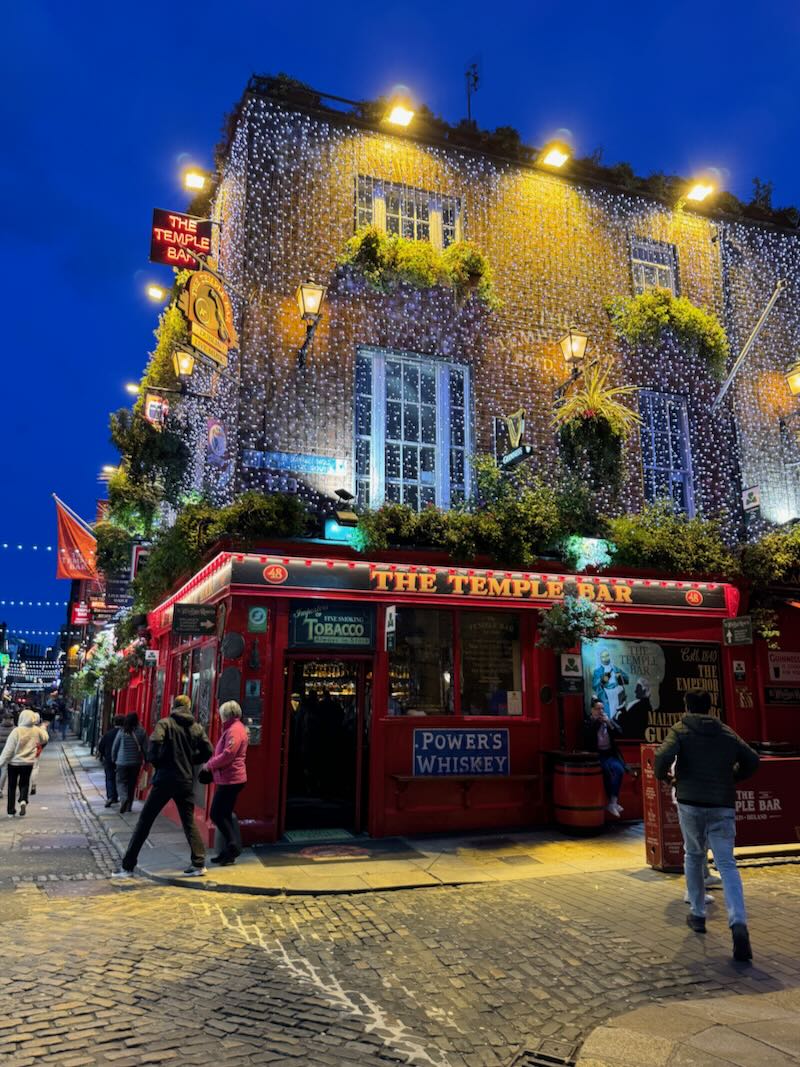
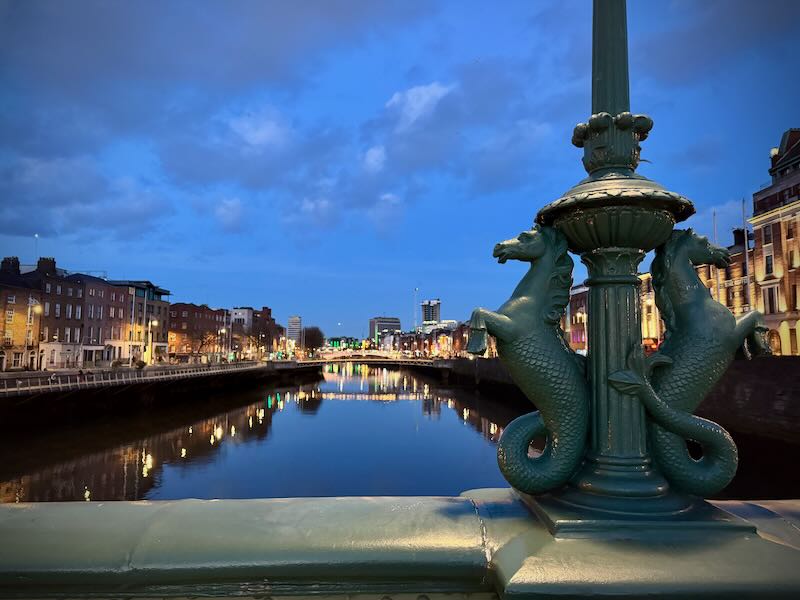
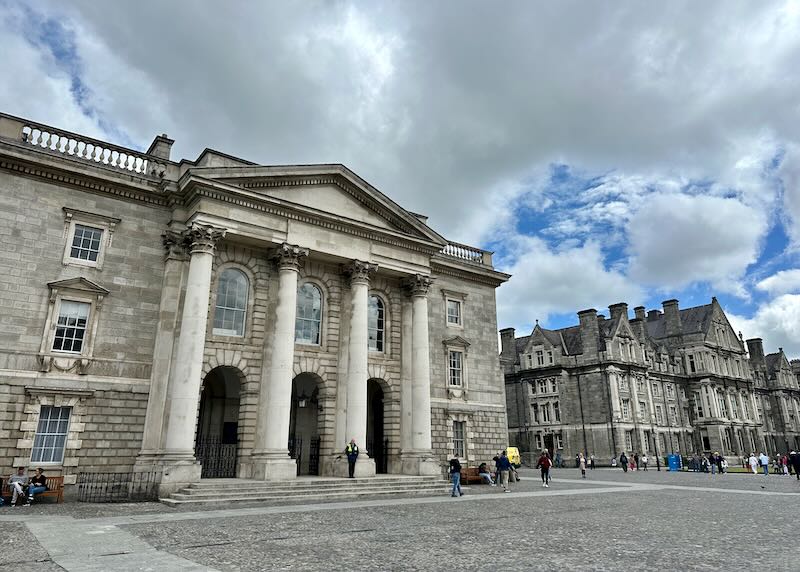
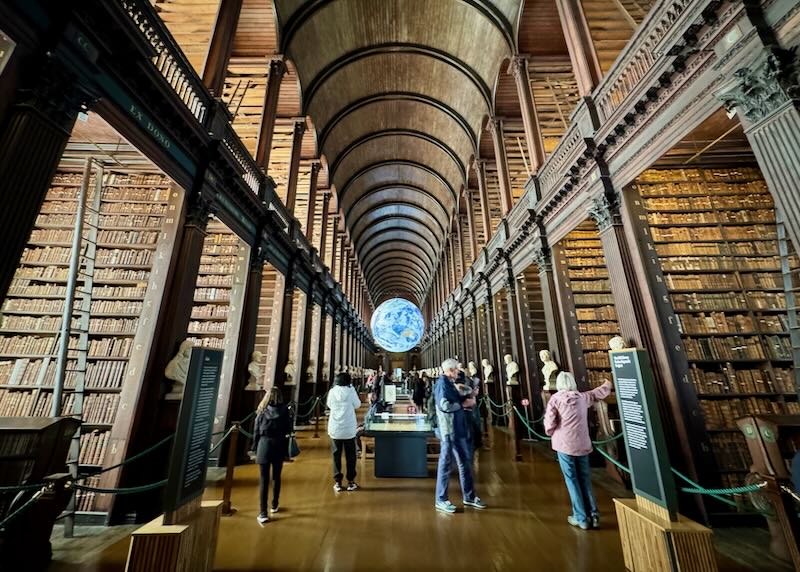
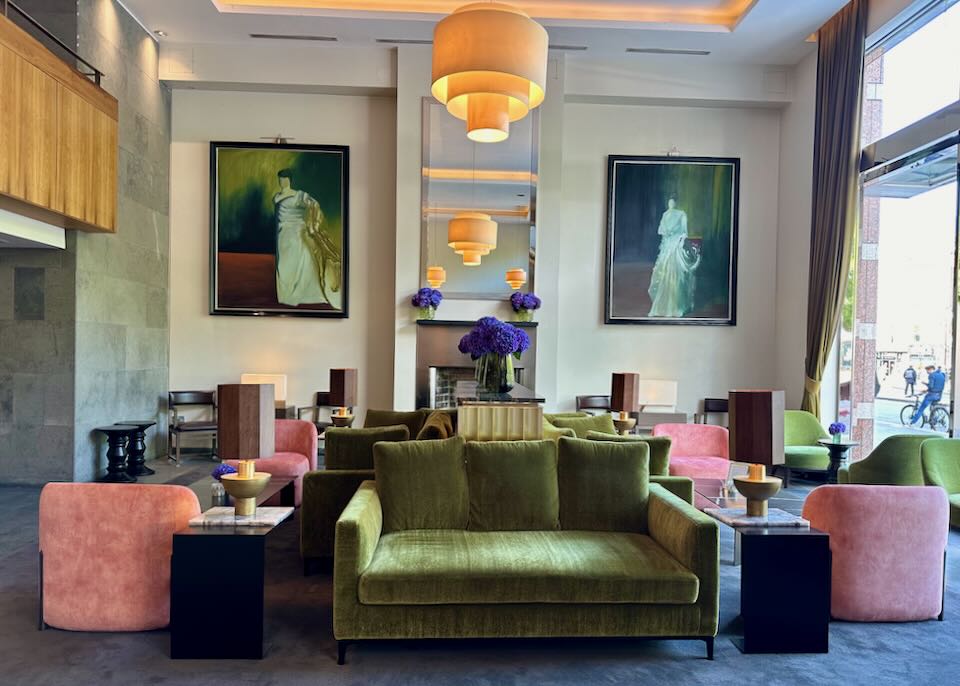
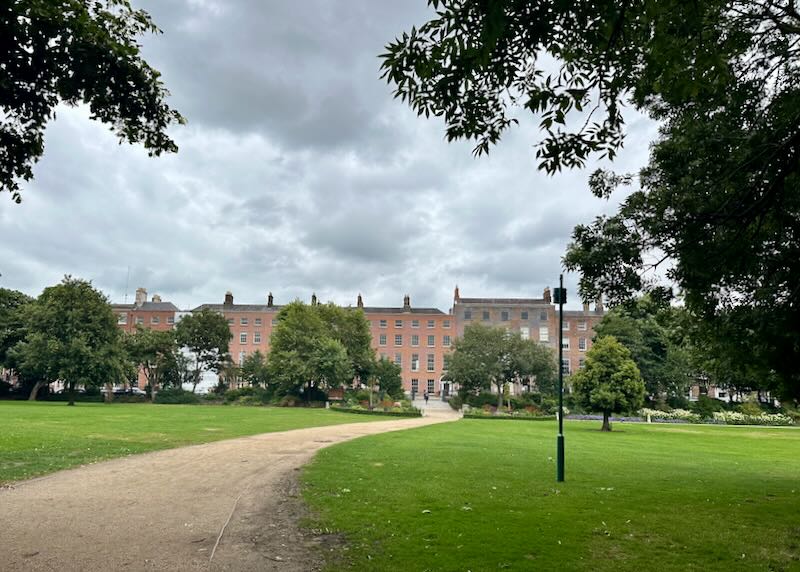
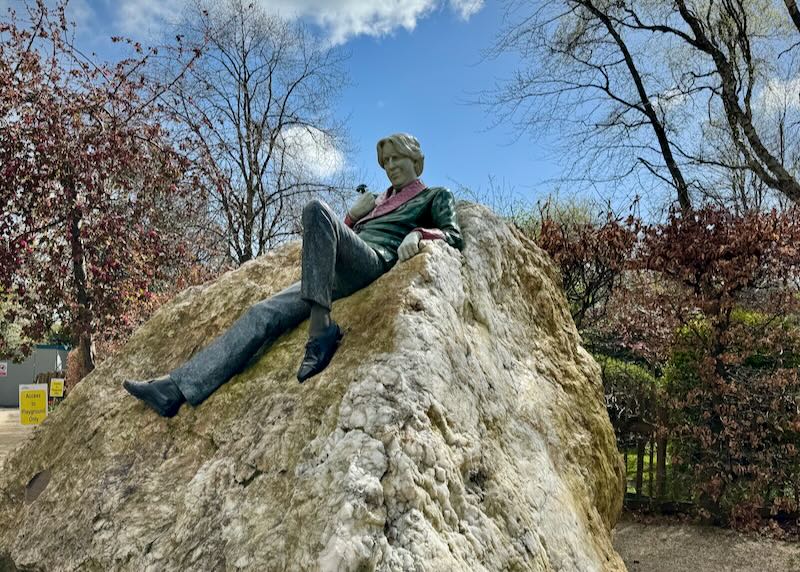
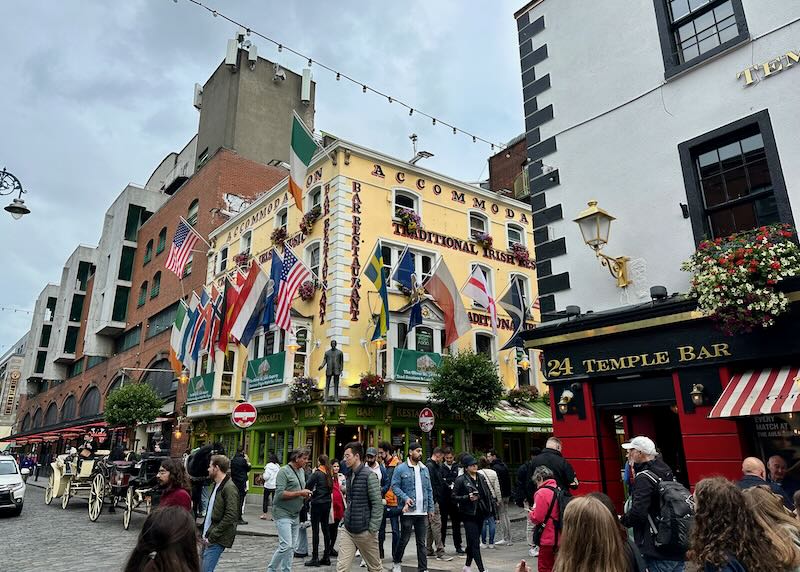
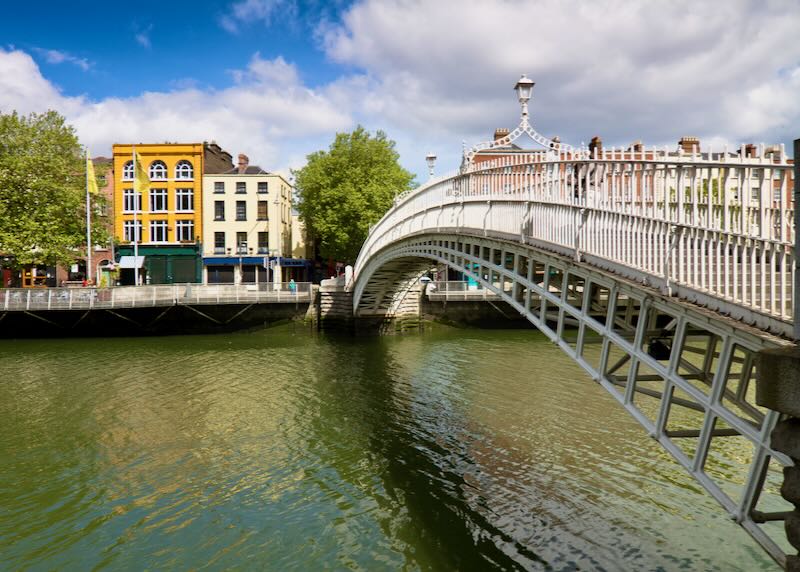
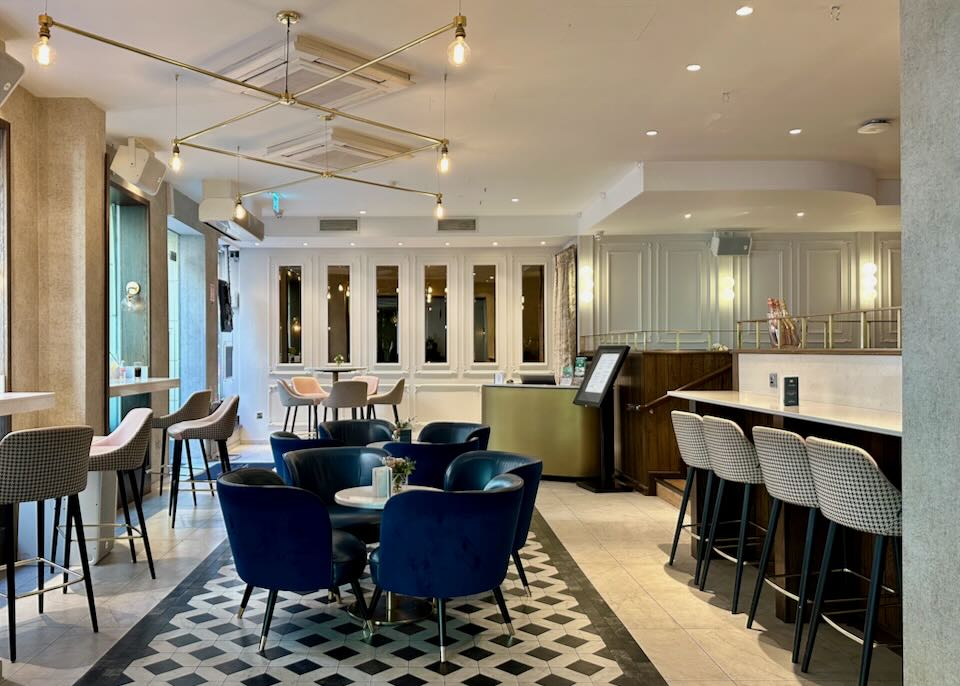
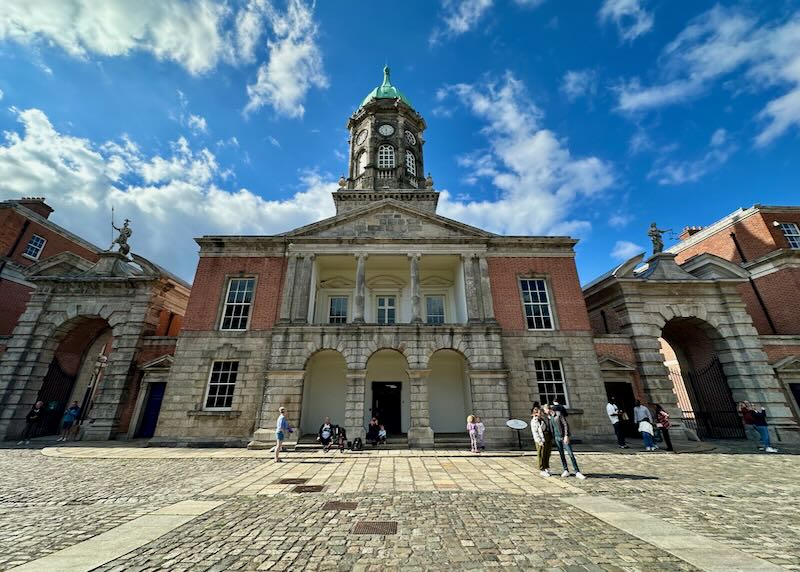

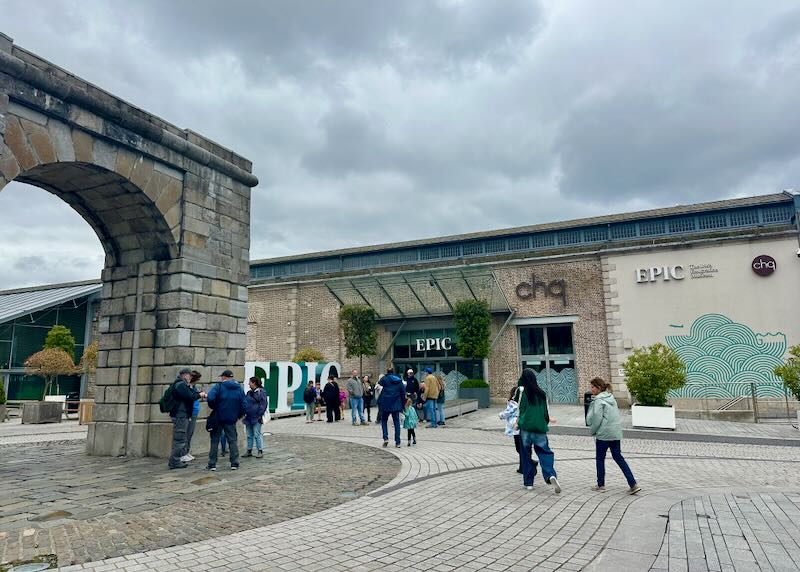
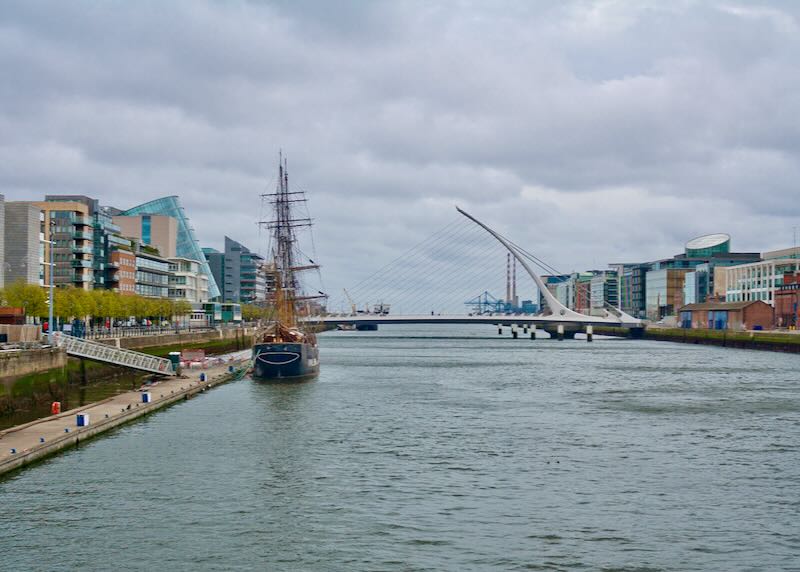
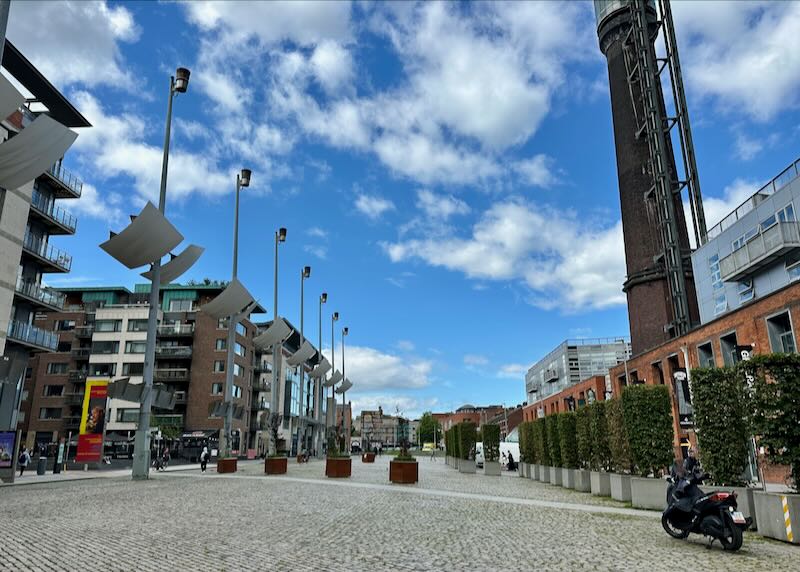
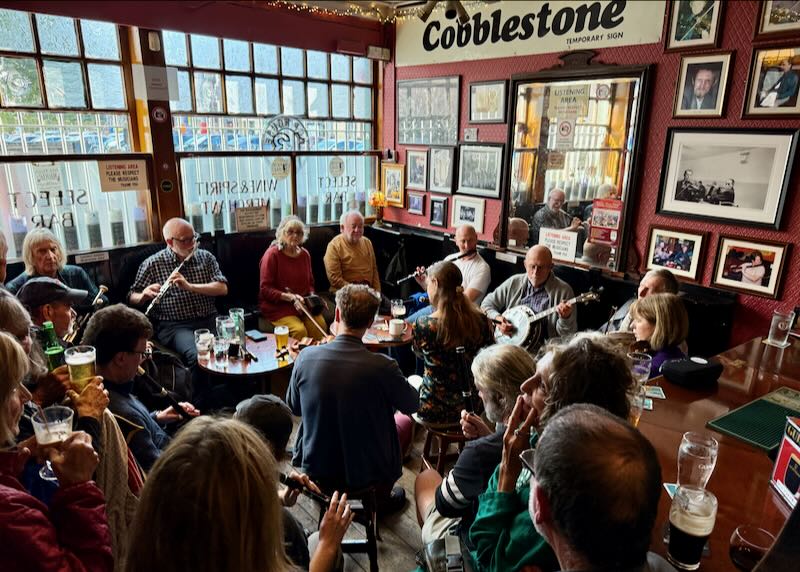
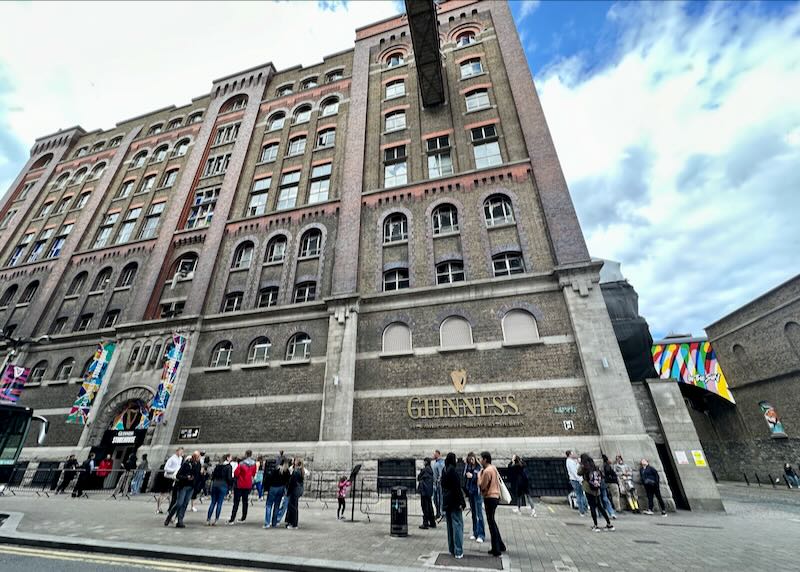
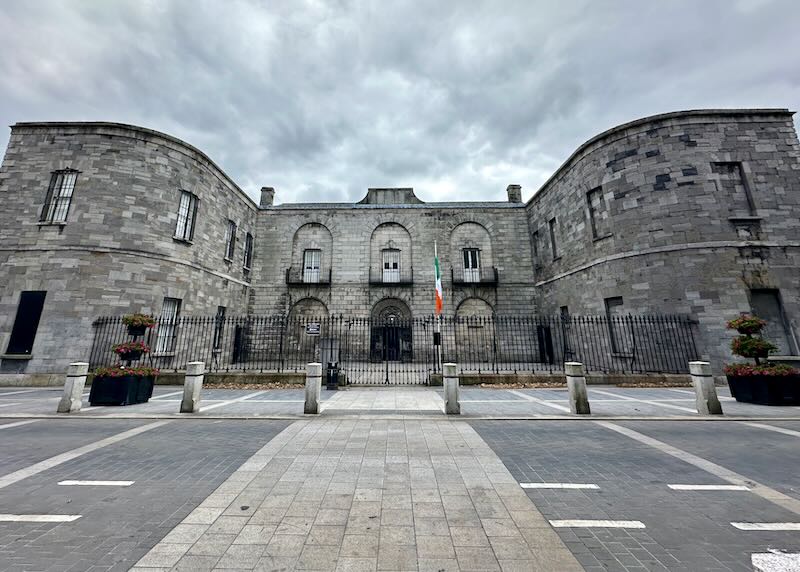
About Santorini Dave